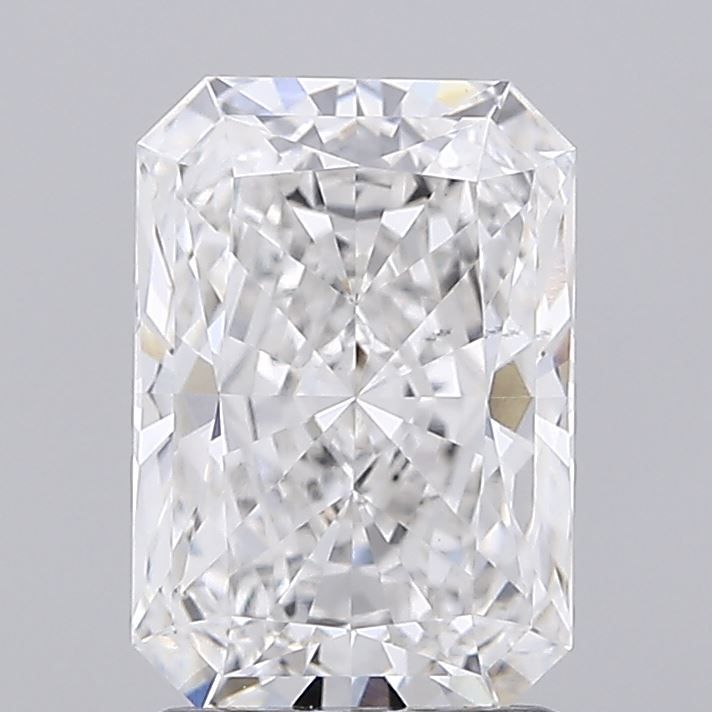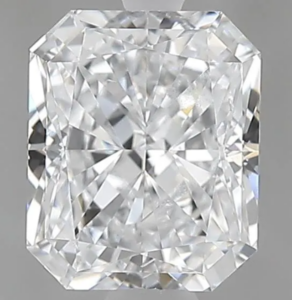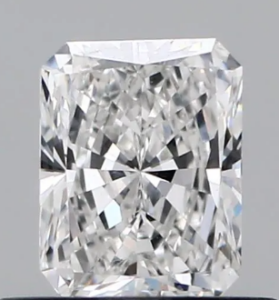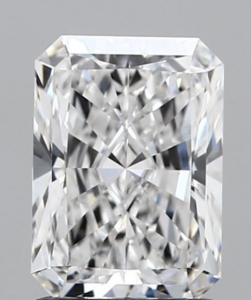Engagement Ring - In Progress
Setting
Stone
We guarantee that every single purchase directly impacts one person's life by giving them access to clean water.
Radiant cut diamonds are sparkly, rectangular stones with clipped corners. The Radiant has a whopping 70 facets, making it one of the most faceted diamond shapes available. Radiants are also quite unique. In fact, at the time of writing, less than 1.6% of diamonds for sale globally were Radiant (17,895 radiant cut diamonds out of 1,178,007 total diamonds). These beautiful diamonds also boast two different cutting styles: crushed ice and traditionally faceted. Read on to learn about which one is right for you!
The cut of a Radiant diamond determines the style and quality of its sparkle. Radiants can be faceted in a traditional manner, giving off large sparkle, or in a more modern manner, giving a “crushed ice” appearance. Unfortunately, the GIA does not grade Radiants for cut. So, if you see a cut grade associated with a Radiant, it is the jeweler assigning it. While this is okay, you should always verify the cut matches your expectations.
Because how well a diamond is cut is the most crucial factor in maximizing the beauty, you want to make sure you understand the ideal cut specifications. The information below serves as a general guideline for evaluating the cut of a Radiant. These specifications will help ensure great sparkle, even brilliance, and elegant length-to-width ratio. You also want to look for a stone that does not have a dark bow-tie.
TRADITIONAL RADIANT TIPS
If you want “big flash” sparkle in your Radiant, you’re going to want to avoid a “crushed ice’ look. Instead, opt for clean lines in the faceting on the bottom of your stone (the “pavilion”). You will often see a star or cross shape formed by the large facets on the pavilion. You also want to look for even areas of contrast (areas of dark reflection) and brilliance (bright reflection). This ensures maximum sparkle.
Here is an example of a beautifully cut traditional radiant with even contrast/brilliance, next to a traditionally cut radiant without enough contrast (note its “washed out” appearance).


CRUSHED ICE RADIANT TIPS
If you want more of a “glitter” appearance in your stone, you want to look for “crushed ice” effect. To accomplish this, look for extra reflections on the pavilion of your stone which create the effect. The top and bottom of your gem will look like “crushed ice.” The same contrast/brilliance rules apply, always look for well spaced dark reflection in addition to white.
Here is an example of beautiful crushed ice cutting, compared with washed out cutting:


The color grade of a Radiant cut diamond refers to how much yellow tint (or lack of a yellow tint) the diamond shows. Smaller Radiants hide color better than larger Radiants do, so depending on the size of diamond you purchase, you may not need to buy a colorless (D-F) diamond, even if you want your diamond to appear colorless. The chart below will help you decide on the color grade of Radiant to purchase based on if you want a colorless diamond, a diamond with a slight tint, or a warmer diamond. It also helps to consider what color metal your radiant engagement ring will be, as warm metal (yellow or rose gold) can hide some diamond color!
CRUSHED ICE RADIANTS
Crushed ice radiants show more color than traditionally faceted stones. This is due to the lesser amount of contrast. As a result, H+ color looks best in crushed ice radiants.
Here is an example of an E colored radiant next to an I colored radiant.


Here are our recommendations:
| WHITE METAL | YELLOW OR ROSE METAL | CRUSHED ICE RADIANTS | |
| >1ct | D-G | D-I | D-H |
| 1-2ct | D-G | D-H | D-G |
| 2+ct | D-F | D-G | D-F |
The clarity grade of a Radiant is based on how many and how severe the internal marks (“inclusions”) of the diamond are. It’s harder to see inclusions in smaller Radiants than in larger ones, so if you are buying a smaller stone you can likely get away with purchasing a lower clarity rating while keeping an eye-clean appearance. In addition, because Radiants have so many facets and a lot of sparkle, they hide blemishes fairly well (especially in comparison to their emerald cut counterparts).
Each couple will have their own standard for clarity. Some may be perfectly comfortable with inclusions as long as they cannot easily see them. Others may insist on a more technically flawless stone. Here is an example of an SI1 clarity stone next to a VS1 clarity radiant.


The clarity information below provides general guidelines for picking a clarity rating for your Radiant based on your inclusion tolerance.
| CLARITY | |
| >1ct | SI1+ |
| 1-2ct | VS2+ |
| 2+ct | VS1+ |
All diamonds in our diamond search engine have the length to width ratio listed. This ratio, which is simply the length divided by the width, determines how skinny or wide the radiant diamond is. The larger the length to width ratio, the longer and more rectangular the Radiant. The smaller the length to width ratio, the more square the Radiant. Our personal favorite range for Radiants is 1.20-1.35.
ABOUT RADIANT HALO RINGS: If you opt to set your Radiant in a halo setting, the diamond may end up looking squarer. This is because the halo gives extra width. To avoid this, opt for a Radiant with a higher length to width ratio.

1.20

1.30

1.40
When looking for a Radiant, make sure to always maximize measurements. For example, you can have a 1.0 carat Radiant with the measurements 6.5 x 5.0 mm that is ideally cut. But, there could also be a 0.98 carat Radiant with measurements 6.6 x 5.1 mm that is just as ideally cut, and likely less expensive. All diamonds in our “Recommended” stone section above have had their dimensions reviewed to make sure they are maximized for their carat weight, while maintaining an ideal cut.
01.
Photo & Video - Always ask the jeweler you are buying from for a detailed picture or video. Look for traditional or “crushed ice” appearance.
02.
Inspect It - Ask the jeweler to pull the diamond and actually visually inspect your radiant cut diamond. Confirm eye-clean appearance.
03.
Measure It - Make sure your Radiant’s length-to-width ratio is pleasing, and its measurements are maximized within your carat size.